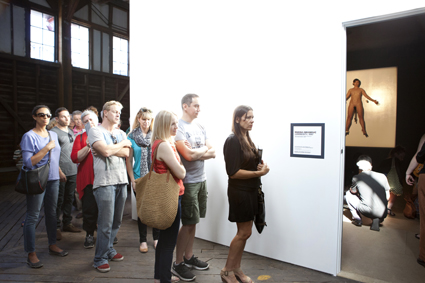Performing in 13 Rooms
Kaldor Public Art Projects, 13 Rooms

Marina Abramovic, Luminosity, 1997, re-performed for Kaldor Public Art Project 27: 13 Rooms
photo Jamie North/Kaldor Public Art Projects
Marina Abramovic, Luminosity, 1997, re-performed for Kaldor Public Art Project 27: 13 Rooms
Sydney dancer Nalina Wait was one of a group of nine performers in 13 Rooms whose task it was to re-perform Joan Jonas’ Mirror Check (1970) and Marina Abramovi?’s Luminosity (1997) at half hourly intervals and alternating between works (plus breaks). In Mirror Check the performer slowly inspects her naked body with a hand mirror. In Luminosity, the naked performer is positioned high up against a wall, arms and legs extended while supported by a bicycle seat.
Wait spoke with Clare Grant, Lecturer in the School of the Arts and Media, UNSW, and her students about the experience. Here are excerpts from Wait’s responses to questions.
Eye contact
We were given the general task to look at the audience: “keep still, move slowly and look at the audience”…But when you actually do that—when you actually lock eyes with someone who doesn’t know you…possibly thinking of you in a kind of objectified way—[there is a sort] of exchange, of seeing each other. It was really quite profound. You’d see people who’d get really upset, freak out and wouldn’t really want be looked at and they’d hide, but couldn’t help but have a little peek. And eventually they’d somehow open up and, ‘Okay, I’ll look back at you.’ And we’d actually meet and that was really quite amazing.
The task
The task was the same [as in dancing]. In dancing, in improvising, normally I’ll develop a task or my body will…or there will be something that I’m doing that is a task that I must do…So in many ways it was just like dancing except mostly just using the eye [which] was the biggest movement. And I got really tired because I tried as much as I could to focus on the people I was looking at and not have a generalised or softened peripheral gaze.
I think about it as a job. The task is to look. I’m constantly thinking about the looking, the engagement of the looking—noticing and refreshing looking, being alive to the looking all the time, not getting tired of it or bored with it, to refresh it and to notice it in every moment.
Being naked
To begin with we took turns in front of each other. The scariest moment was the first time, taking your coat off and standing up there. But after a while we got used to it with each other. Then we extended the length of time we were doing it for, to negotiate how to do that over time, what kind of things you need to do in yourself to maintain that and build up to it…[W]hen the public actually came in…they were so open and taken by [the work]. I realised I didn’t need to push them or hold them in their place with my gaze. I could actually be more receptive and compassionate and more active in it, communicate within it rather than hold them back and defend myself. But it took a bit of time to come to that. I only realised I was doing that after one guy left and he said, “That chick was fully eye-balling me” or something…I thought, oh yes, I’ve got to also receive through the eye a little bit more.
Agency
[The gaze] is where I had agency. Other than that I felt much like I might if I was in a dance piece in which the choreography was exactly set and I had no room to really interpret..It was more restricted than I’ve ever [been]. I did as much as I could [with my eyes] because I felt that was where I was.Vulnerability
If there was the occasional person trying to undermine the performance I just thought about being Jesus…(LAUGHS), being compassionate towards them. This is your situation…it’s not actually mine. [I was] trying to be compassionate with them having an issue with it inside themselves, inside the work. Because it is confronting work.
Focus
For me, in Mirror Check there was even less agency [than in Luminosity]. I tried to squeeze as much agency as I could from it …or interest. I think that’s what the work is, finding interest in the task. And after the thousandth time of looking at your own reflection in the mirror, it is boring. It really is. But if there is some way that you can focus—I had to do it through focus mostly. I just had to literally see every little thing and be engaged with it in the scene for me to feel like I was doing the work. And I noticed if I ever just slightly shifted my vision, or went out of focus, the atmosphere of the room would break and people would leave. You feel like you’re doing this quite personal thing, but people feel it.
Mirror Check was tricky for me because I prefer to be able to see the people in the room and feel we’re all in there together rather than…keeping a fourth wall in a performative sense and not looking at anyone, which I found difficult. I had to look…even if it was at the wall or somebody’s shirt so I could still feel engaged.
So I felt slightly disconnected from the audience but then again I’d finish a round and someone would applaud. So it’s like, okay, you’re with me. Then I’d just listen more to the tone of the room, to feel whether people were with me. That’s when I noticed if I went out of focus, it would break.
Kaldor Public Art Projects, 13 Rooms, curators Hans Ulrich Obrist, Klaus Biesenbach, 11-21 April, Pier 2/3, Walsh Bay, Sydney
RealTime issue #115 June-July 2013 pg. 8






